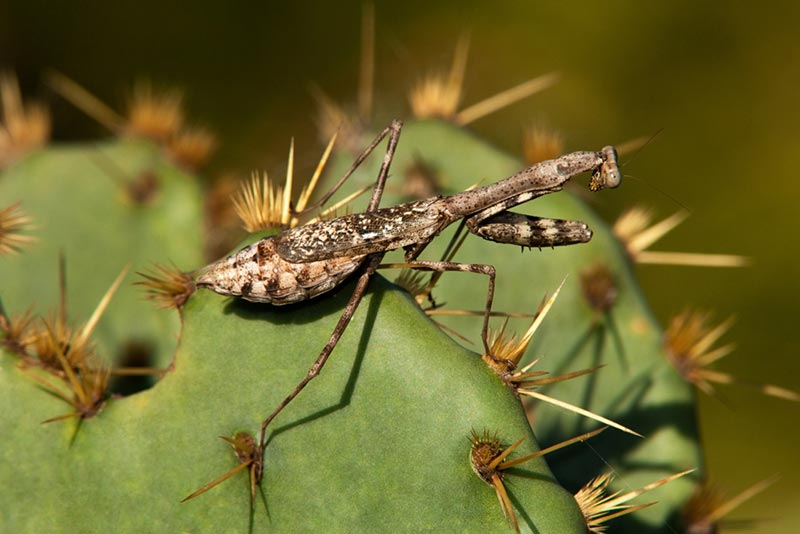What Is the State Insect of South Carolina? Facts, Feeding, & Breeding Habits
-

- Last updated:

Even if you find them a little creepy, praying mantises carry a “cool” factor that no other insect can replicate. You might describe most bugs as gross, destructive, dangerous, or even beautiful, like South Carolina’s state butterfly. But before anything, mantises are weird and intriguing. Their bizarreness is attractive, and watching them hunt prey through adaptability and speed is genuinely fascinating.
Plus, it’s almost impossible not to be at least a little cool when you inspire an entire martial arts style. That appeal is one crucial reason South Carolina named the Carolina mantid its state insect. Learning something new about these unique creatures is always exciting, so let’s dive deeper to discover more about this state symbol.
South Carolina’s State Insect: The Carolina Mantid
South Carolina officially established the Carolina mantid as its state insect in 1988. An intriguing specimen when viewed in nature, it earns appreciation as a beneficial insect across the state. The designation, outlined in Act 591, highlights the importance of entomology and the insect’s part in agricultural pest control. At the same time, it serves a vital role in fostering interest in natural sciences among children.
As one of over 2,000 mantis species, the Carolina mantid (Stagmomantis carolina) lives across Central and North America. The insect is particularly prevalent across the East Coast and abundant in South Carolina’s varied habitats. It grows 2–3 inches long, with the male sporting long wings for flying and the larger female having shorter wings that keep her grounded.
It can be challenging to spot the camouflaged Carolina mantid in the wild. It takes on many hues and patterns to blend into its surroundings. Some may be a spotted gray color to blend in with rocks on the ground, light green when it is among the leaves, and brown to mimic a twig. The mantis molts several times before reaching adulthood.
Carolina Mantid Feeding and Breeding Habits
Camouflage helps the Carolina mantid take cover and sneak up on its prey. Small insects such as moths, flies, bees, butterflies, wasps, and caterpillars are essential food sources. The mantis attacks and subdues its prey through lightning-fast strikes with its forelegs. Sharp spikes along the legs dig into the insect’s body and provide a strong hold while the mantis feeds on the still-alive prey.
Female mantises are well-known for their cannibalistic habits following mating. About 25% of females feed on males after the act. Some experts believe it is retaliatory due to an unwanted mating session. Others feel that feeding is opportunistic when the female has no other available food. With nothing else to eat, larger mantises of either sex will attack smaller specimens.
Despite the mantid’s undiscriminating and sometimes undesirable diet, many people see it as a viable pest control measure. Many gardeners and homeowners buy egg sacs from dealers to release into their gardens.
In the fall, the female Carolina mantid produces an elongated egg case called an ootheca. The ootheca emerges in a frothy foam that solidifies to withstand the elements. She attaches the protective sac to tree bark, branches, fence posts, and siding. Each ootheca can contain 50–200+ eggs and take up to 6 months to hatch.
The ootheca is long and slender, featuring organized alternating light and brown stripes. The egg sac is a crucial distinguishing detail for South Carolina residents looking to give the state insect a helping hand.
Carolina Mantid Competition
Unfortunately, most of the oothecae you can buy aren’t Carolina mantid eggs but rather those from the Chinese mantis. The Chinese mantis (Tendoera sinensis) came to America in 1896 and has been stealing territory from native species since. At up to 5 inches in size, the Chinese mantis outmatches the Carolina mantid and often targets its small-bodied relative as a food source.
The European mantis (Mantis religiosa) is another Carolina mantid competitor; it’s a 4-inch-long species discovered in America only a few years after the Chinese mantis. Apart from its larger size, the yellow dots inside its forearms make it easy to differentiate from Carolina mantids. Non-native species compete for food sources with the Carolina mantid but eat a more diverse diet, including reptiles, frogs, and even small birds.
European mantis egg cases look like those of the Carolina mantid. You’ll see the difference in the stripeless pale brown coloration in the European mantis egg case. Chinese mantis oothecae have a messier, bulbous look, often taking the appearance of a toasted marshmallow. Some experts recommend removing Chinese and European mantis oothecae if you find them to control populations.
Final Thoughts
The Carolina mantid holds special meaning in South Carolina, symbolizing a passion for the natural sciences and a desire to pass knowledge and values on to future generations.
It’s always intriguing to see these creatures in nature, but try to take a closer look the next time you spot a praying mantis. The Carolina mantid isn’t endangered, nor are non-native species particularly harmful to the ecosystem. But knowing what’s lurking in your backyard can help you do your part to help this state symbol thrive.
Featured Image Credit: Danita Delimont, Shutterstock
Contents

